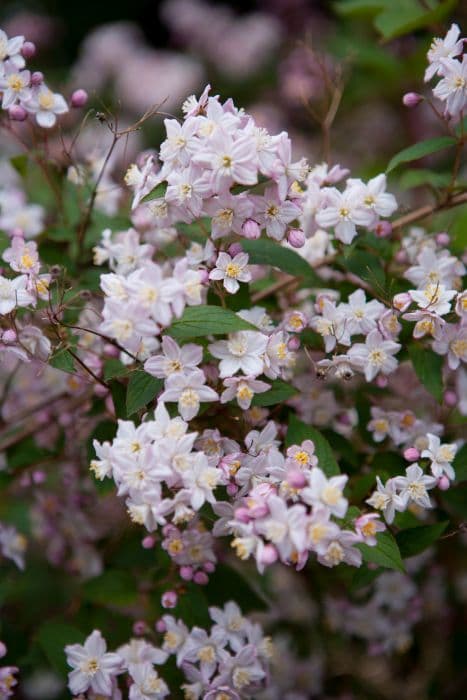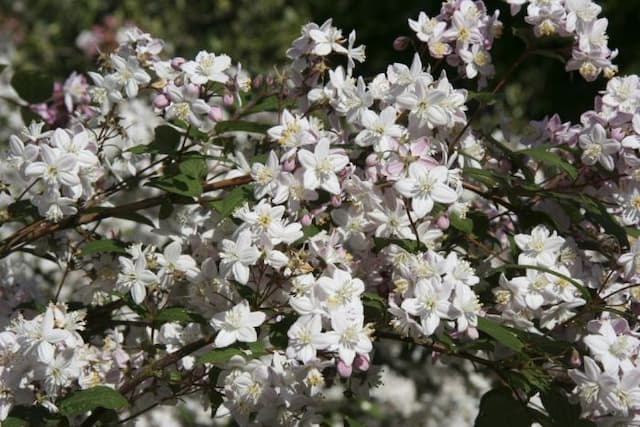Paniculate hydrangea [Vanille Fraise] Hydrangea paniculata Vanille Fraise = 'Renhy' (PBR)
![paniculate hydrangea [Vanille Fraise]](/_next/image?url=https%3A%2F%2Fplants-admin.emdemapps.com%2Fimages%2Fplants%2F%2Fimages%2F604b5813e1ca9.png&w=3840&q=75)
ABOUT
[Vanille Fraise] is a large-flowered cultivar that performs from mid-summer to mid-autumn. Fluffy, loose, pyramid-shaped flower panicles are creamy-white, turning shades of pink as they age, before finally taking on rich pink tones
About this plant
 Names
NamesSynonyms
Vanilla Strawberry Hydrangea, Vanilla Fraise.
Common names
Hydrangea paniculata 'Renhy'
 Characteristics
CharacteristicsLife cycle
Perennials
Foliage type
Deciduous
Color of leaves
Green
Flower color
Mixed
Height
6-8 feet (1.8-2.4 meters)
Spread
6-8 feet (1.8-2.4 meters)
Plant type
Shrub
Hardiness zones
3-8
Native area
Asia
Benefits
 General Benefits
General Benefits- Attractive Flowers: Produces large, cone-shaped flower clusters that transition from white to pink, providing visual interest throughout the growing season.
- Seasonal Change: Offers a changing palette of colors as the seasons progress, with blooms that deepen to rich strawberry-pink in fall.
- Landscaping Versatility: Can be used in a variety of landscape designs, including borders, hedges, and as a focal point specimen.
- Pollinator Friendly: Attracts bees, butterflies, and other beneficial insects, supporting local ecosystems.
- Cold Hardy: Adapted to a wide range of climates and can withstand cold winters, making it suitable for many temperate gardens.
- Easy to Grow: Known for being low maintenance and easy to care for, requiring minimal pruning and regular watering.
- Drought Tolerance: Once established, exhibits some level of drought resistance, reducing the need for constant watering during dry spells.
- Long Blooming: Offers an extended blooming period from early summer to late autumn, providing long-lasting color and interest.
- Urban Tolerant: Capable of adapting to urban conditions, including pollution and limited space, making it ideal for city gardens.
- Cut Flowers: The blooms are suitable for cutting and can be used in floral arrangements, adding aesthetic value both indoors and out.
 Medical Properties
Medical PropertiesThis plant is not used for medical purposes.
 Air-purifying Qualities
Air-purifying QualitiesThis plant is not specifically known for air purifying qualities.
 Other Uses
Other Uses- Photography Prop: The captivating colors of Hydrangea paniculata Vanille Fraise make it an excellent subject for photographers, particularly in macro photography where the gradient of color can be appreciated.
- Art Inspiration: Artists may use the stunning blooms of the plant as inspiration for paintings, drawings, or textile designs, capturing its transition from white to pink.
- Culinary Decoration: While not edible, the flowers can be used as a decorative element on cakes or dessert trays at events, although they should be removed before consuming the food.
- Festive Garlands: Dried Hydrangea paniculata Vanille Fraise flowers can be strung together to create natural, decorative garlands for festive occasions or interior decor.
- Education Tool: The plant can serve as an educational tool in botany classes to illustrate plant growth, flower development, and pruning techniques.
- Ice Embedding: Blooms of this hydrangea can be frozen into ice blocks for decorative display in ice sculptures or to chill beverages in a visually appealing way.
- Natural Dye: The petals of the Hydrangea paniculata Vanille Fraise can be used to produce a delicate natural dye for artisanal fabrics or crafts.
- Bookmark Crafting: Pressed flowers from this hydrangea can be used in creating handmade bookmarks, offering a charming and personalized touch to reading materials.
- Floral Perfume Base: Although not a traditional use, the flowers could potentially be used to create a light, floral-scented base for handmade perfumes or scented oils.
- Wedding Confetti: Petals from the flower, when dried, could be used as natural, biodegradable confetti at weddings, providing an environmentally friendly alternative to paper or plastic.
Interesting Facts
 Feng Shui
Feng ShuiThe Hydrangea is not used in Feng Shui practice.
 Zodiac Sign Compitability
Zodiac Sign CompitabilityThe Hydrangea is not used in astrology practice.
 Plant Symbolism
Plant Symbolism- Heartfelt and Sincere Emotions: Hydrangeas are often associated with genuine, heartfelt emotions. The Hydrangea paniculata Vanille Fraise, with its lush, full blooms, exemplifies an abundance of feelings.
- Gratitude: The luxurious fullness of the blooms represents the overflowing nature of gratitude, often given in thanks for understanding.
- Apology: In some cultures, hydrangeas symbolize an apology or a desire for forgiveness, making them suitable for a conciliatory gesture.
- Beauty: The striking appearance of the Vanilla Strawberry Hydrangea, with its stunning white to pink flowers, denotes beauty and grace.
- Pride: The robust nature of the plant can be symbolic of boastfulness or vanity, in some contexts representing pride.
 Water
WaterThe Vanilla Strawberry Hydrangea (Hydrangea paniculata 'Renhy') requires consistent moisture and should be watered deeply once a week, with modifications made for rainfall and temperature. During hot or dry weather, increase watering to twice per week. Each watering session should provide about 1 inch of water, which amounts to roughly 0.62 gallons per square foot or about 2.5 gallons for an average-sized plant. It's important not to let the soil dry out completely, but also to avoid waterlogging as this can lead to root rot.
 Light
LightVanilla Strawberry Hydrangea thrives in full sun to partial shade. The ideal spot for planting is one that receives direct morning sunlight and some afternoon shade, especially in hotter climates. This ensures the flowers do not get scorched while the plant receives enough light for optimal growth and blooming.
 Temperature
TemperatureThe Vanilla Strawberry Hydrangea can tolerate temperatures as low as 0°F but performs best in areas where the average minimum winter temperature is between 20°F to 30°F. It thrives in temperatures ranging from 65°F to 75°F during the growing season. Extreme heat can be detrimental, so if temperatures exceed 86°F, providing shade and extra water will help the plant cope with the stress.
 Pruning
PruningPruning Vanilla Strawberry Hydrangea in late winter or early spring promotes healthy growth and abundant blooms. Remove old, dead wood and about one-third of the oldest stems to encourage new, vigorous growth. Pruning also helps maintain the plant's shape and size. The best time for pruning is just before the plant breaks dormancy, after the worst of the winter cold has passed.
 Cleaning
CleaningAs needed
 Soil
SoilVanilla Strawberry hydrangea thrives best in well-draining, moist soil with high organic matter content. A soil pH of 6.0 to 7.0 is ideal for this plant. A good soil mix can be made with equal parts of garden soil, compost, and peat moss or well-rotted leaf mold to ensure proper drainage and fertility.
 Repotting
RepottingVanilla Strawberry hydrangeas typically do not need to be repotted often as they are outdoor plants. However, if grown in containers, they should be repotted every 2-3 years or when they outgrow their current pot to ensure adequate root space and soil nutrients.
 Humidity & Misting
Humidity & MistingVanilla Strawberry hydrangea prefers an environment with average to high humidity. It does not have specific humidity requirements but thrives in conditions that mimic its natural habitat, which typically includes moist air.
 Suitable locations
Suitable locationsIndoor
Place in bright, indirect light with moist soil.
Outdoor
Plant in partial shade, moist, well-draining soil.
Hardiness zone
3-8 USDA
 Life cycle
Life cycle'Vanille Fraise' Hydrangeas begin their life cycle as dormant bare-root plants or as young plants with a rudimentary root system housed in containers. Upon planting, they enter a growth phase, developing extensive root systems and foliage during the spring. As summer progresses, they start to bloom, showcasing large, cone-shaped flower panicles that transition from white to a striking pink or strawberry hue. Following the flowering period, which lasts through late summer into fall, the plant's flowers may fade to beige and the leaves will eventually fall off as the plant enters dormancy during the winter months. Throughout the growing season, 'Vanille Fraise' Hydrangeas will undergo vegetative growth and may require pruning in late winter or early spring to encourage new growth and improve flowering. As perennials, these Hydrangeas will repeat this cycle yearly, maturing and potentially expanding in size with each successive season.
 Propogation
PropogationPropogation time
Late winter to early spring
The Hydrangea paniculata 'Renhy', commonly known as Vanilla Strawberry Hydrangea, is most commonly propagated through softwood cuttings. Softwood cuttings are taken from the new growth of the plant in late spring to early summer when the stems are still tender and flexible. A 4-6 inch cutting is snipped just below a leaf node, where a pair of leaves attach to the stem. The lower leaves are removed, and the cut end is dipped into rooting hormone to encourage root development. The prepared cutting is then inserted into a pot filled with moistened potting mix or a 50:50 mix of peat and perlite. To maintain high humidity, a plastic bag or a propagation dome can be placed over the pot, careful to keep the plastic from touching the leaves. The cutting should be kept in indirect light and consistently moist until roots have formed, which typically takes 4 to 8 weeks. After rooting, the new plant can be transplanted into a larger pot or directly into the garden.








![Hydrangea [Early Sensation]](/_next/image?url=https%3A%2F%2Fplants-admin.emdemapps.com%2Fimages%2Fplants%2F%2Fimages%2F604b6150338db.png&w=640&q=75)
